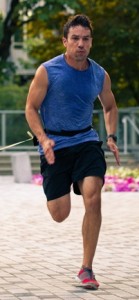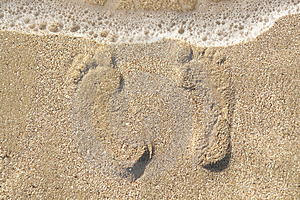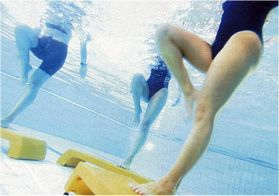by Michelle Sutton-Kerchner
With the primary responsibility of keeping us mobile, our feet deserve pampering. Being down there on the ground, they are often forgotten and unappreciated. Here’s how to keep those toes from crying all the way home …
Whether you’re working out, standing in line, or dancing the night away, your feet make it happen. Yet, unless foot pain shouts for attention, we’re usually looking elsewhere (hopefully up). Summer’s heat can trigger a battle cry. Treat foot ailments promptly before sweaty, hot feet take your health in the wrong direction.
Soggy Socks

Warm, moist environments are an ideal breeding ground for bacteria. Infections, such as athlete’s foot, are more common when temps soar. Feet stuck in damp sneakers as we sweat off the pounds or sightsee the town are uncomfortable as well as susceptible. Although you may wish to abandon socks or, worse, shoes, it’s best to keep feet cool and dry in supportive enclosure.
To reduce sweaty feet, try a spray-on antiperspirant. Use the same type sold for underarm protection. A podiatrist can also prescribe a stronger product, if necessary. Wear moisture-wicking socks. Don’t be fooled by trends. Although folks may appear to have abandoned their socks, they are really wearing a no-show ankle sock, sold everywhere from the grocery check-out to upscale department stores. Buy a stash of them. Never subject yourself, and those around you, to bare feet in shoes. It’s unhealthy (and could be stinky).
Swollen Feet
Increased activity in hot, humid weather often leads to swollen feet. Podiatrists recommend drinking more water, eating less salt, and getting plenty of exercise. Exercise improves circulation. The increased blood flow helps reduce swelling. If possible, elevate your feet during the day. Try using a stool under your desk or elevating on the couch while watching an evening TV show. Before bed, a refreshing soak in a cool foot bath is helpful. Add Epsom Salts as an extra soother.
Don’t Dare Go Bare
Save your dares for something fun and exciting, like that advanced kickboxing class. Walking around barefoot is an invitation to germs. Strappy, open sandals also increase exposure.
According to Philip Tierno, PhD, director of microbiology and immunology at New York University’s Langone Medical Center, the ground outdoors is often covered with various strains of contamination, including Staphylococcus aureus, which can cause skin infections or blood poisoning; E. coli; and drug-resistant bugs like MRSA. Cuts or blisters on your feet are an open invitation for these nasty lurkers. Experts suggest washing feet when returning home. For a quick on-the-spot refresher, hand sanitizer does the job on feet, too.
Walking barefoot also increases risk of injury, even during a quick jaunt to the mailbox. It also may cause musculoskeletal foot problems. Lack of arch support can cause discomfort that haunts you in other ways. That back ache you’ve been suffering may be from flip-flopping around or going shoeless.
Backless shoes or flip-flops not only lack support but also cause your feet to work harder. With each step, foot muscles need to grip the shoe to keep from losing it. Backless shoes also pose a tripping hazard, being the cause for many visits to the emergency department. Try sandals. Their open nature allows feet to breath and keep cool, but they still offer a cushion and protection.

Corns, calluses, and blisters are common summer souvenirs. Heat, sweat, and sunburn can irritate these into existence. Tight-fitting shoes are another culprit, causing blisters and the thick, hard sections of skin associated with corns and calluses. Apply blister pads over the blisters and donut-shaped pads over the corns and calluses. They absorb the friction and allow healing. In severe cases, a podiatrist may need to trim the skin of corns and calluses to relieve pressure and pain.
For more on shoe choices, see “If the Shoe Fits, Should You Wear It?” at www.fitnessandwellnessnews.com/health/if-the-shoe-fits-should-you-wear-it (F&W News, August 6, 2010).
Athlete’s Foot
You don’t have to be an athlete to suffer from athlete’s foot. Considered the most common fungal skin infection, it easily spreads by direct contact with a contaminated surface. (Another reason to avoid going barefoot.) The Center prides itself on providing a sanitary environment, but it’s always best to wear water shoes in public showers, locker rooms, and pools. Athlete’s foot can be passed by an innocent brush with another’s toes or feet. Contact with the fungi can cause the infection to spread, even if the carrier does not have the infection.
Athlete’s foot causes skin to itch, crack, and flake. Specific symptoms depend on the type: toe web, moccasin, and vesicular. Some infections are bacterial in nature, which worsen the symptoms and require additional treatment. A bad infection can affect the toe nails, which need a separate fungal treatment.
Over-the-counter remedies are often effective. However, if you’ve never had athlete’s foot, consider being checked by a physician for a positive diagnosis. You should also visit your physician if the condition persists.
Keep feet dry with sweat-wicking fabrics and talcum powder. Leave room in your shoes for feet to breathe. Fungi thrive in tight shoes that don’t allow air to circulate. Some are more susceptible to athlete’s foot than others. Prevention is always best, especially since those who contract athlete’s foot are more likely to suffer from it again.
Foot Stress
Your feet support the weight of your entire body throughout daily activities. Being overweight has an obvious impact on the stress your feet endure. A regular fitness routine helps maintain a healthy weight and circulation. The affects of weight gain on foot health are not limited to the obese. Even 25 extra pounds can lead to foot and ankle problems, according to James Mahoney, DPM, an associate professor of podiatric surgery at Des Moines University in Iowa.
Painful foot conditions associated with too much body weight include: osteoarthritis, inflammation in the plantar fascia (the tough band of tissue in the sole of your foot), and tendon inflammation. Arches and tendons in the feet and ankles can be affected by an improper gait from carrying additional weight. This can lead to hip and back issues, along with foot pain.
The National Institutes of Health warn that being overweight increases your chance of gout, a condition that causes sharp pain, especially in the big toe. Gout is triggered by uric acid accumulating in the joints. When overweight, the body produces more uric acid.
Excess body weight often contributes to the risk of diabetes, which causes foot numbness and restricts blood flow to the feet. Foot infections are common in this population because small injuries often go undetected. Infection can ensue and lead to life-threatening circumstances. Statistics show in one year, more than 70,000 individuals had to have their foot or lower leg amputated, as a result.
Peripheral arterial disease is defined by accumulated plaque in the walls of leg arteries. According to the American Heart Association, being overweight is a preventable risk factor for this condition, which decreases blood flow to the feet.

Talk with a personal trainer about the most effective exercises for weight reduction when struggling with subsequent foot problems. (Best yet– commit to a fitness program before foot health fails!) Low-impact aerobic activities are often recommended. Consider an aquatic workout, which can reduce weight without further straining joints and feet.
The Center’s nurse provides evaluations on a regularly scheduled basis to motivate you in your efforts and monitor your vitals. If you’ve been sedentary, schedule a routine physical with your physician prior to beginning a new fitness program. Just as with the feet, excess weight can certainly strain heart and lungs.
With simple hygiene practices and a healthy workout, anyone can be light on their feet. And, the occasional pampering with a soak, massage, or pedi always helps you go the extra mile.
Sources
“8 Summertime Foot Hazards,” by Wyatt Myers at www.everydayhealth.com.
“Athlete’s Foot Causes, Symptoms, and Treatment,” at www.everydayhealth.com.
“Calluses, Corns, and Your Feet,” by Diane Rodriguez at www.everydayhealth.com.
“Losing Weight Can Also Help Your Feet,” by Eric Metcalf at www.everydayhealth.com.
Image Credits
Resting bare feet with sneakers (introductory photo): www.flickr.com/photos/perfectoinsecto/1429821251/
Feet in sand: © Natalie Shmeleva at www.dreamstime.com.
Man sweating: www.flickr.com/photos/lululemonathletica/4883557237/
Water workout: www.flickr.com/photos/24975064@N05/4840948510/
 Fitness & Wellness News Your Source for Fitness News, Wellness News, Health News, and Nutrition News!
Fitness & Wellness News Your Source for Fitness News, Wellness News, Health News, and Nutrition News!



